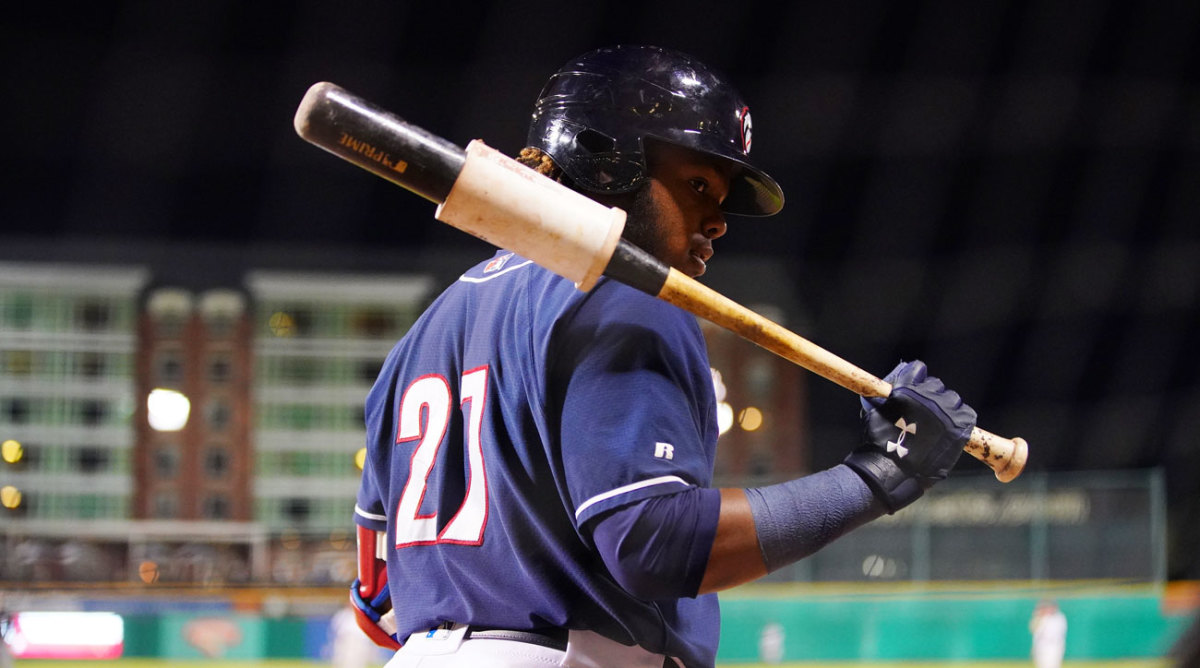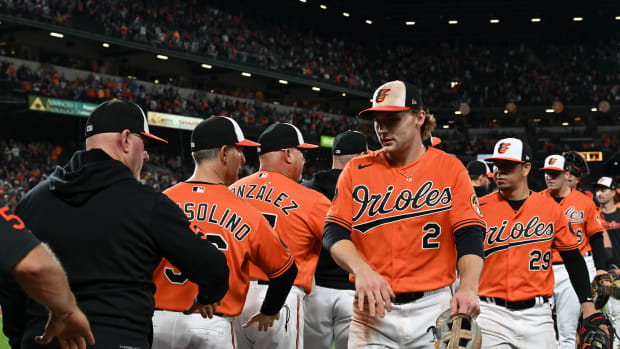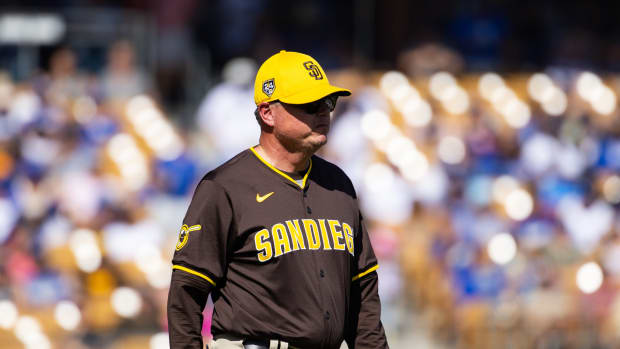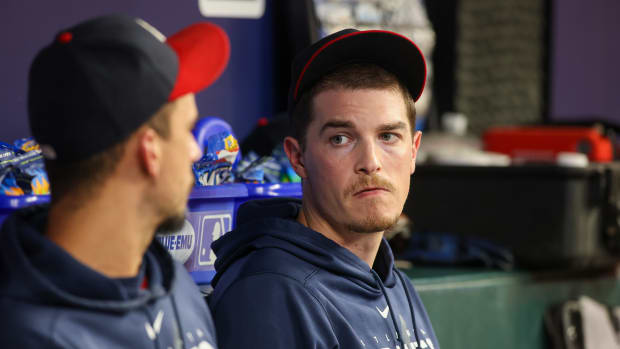Welcome to the New Era: 19-Year-Old Vladimir Guerrero Jr. Is Baseball's Most Exciting Prospect

Before the question is even all out, New Hampshire Fisher Cats manager John Schneider is laughing. On a mid-May afternoon in Hartford, the genial skipper of the Toronto Blue Jays’ Double A affiliate is in the process of being asked to weigh in on the season his 19-year-old third baseman, Vladimir Guerrero Jr., is having. His answer is somewhere between an impressed chuckle and a nervous giggle. This is the common response when even seasoned baseball men discuss a player who is so clearly superior to his peers that he makes the game look like MLB The Show with the difficulty turned all the way down, or like Mike Trout suiting up in a Little League game. It’s joy mixed with disbelief, like you just found a winning lottery ticket on the street.
Schneider laughs because, really, how else can you react to what Guerrero is doing? Every game brings another three- or four-hit outing (he’s had seven in 41 games), another thunderclap homer, another vapor trail of a line drive. The English language, it seems, can’t describe how good and exciting Vlad Jr. is.
“He’s doing okay,” Schneider says, but then he laughs again, amused at the understatement. In two months of the 2018 season, he’s raised the already high expectations for him—no easy feat for the progeny of Vlad Sr., who racked up 449 career home runs and is one of the greatest hitters the Dominican Republic ever produced.
The stats from Vlad Jr.’s first season in Double A inspire spit takes. Through 41 games, the 6' 1", 200-pound phenom is hitting .425/.479/.694 with eight home runs, 45 runs driven in and more walks (18) than and as many doubles (17) as strikeouts (17). He’s done this as the youngest player in the entire Eastern League, five years younger than the league’s average player. He is the most heralded teenage prospect since Bryce Harper, and seemingly as sure a thing to be a superstar.
“He’s made the hardest thing in sports look easy,” says one veteran scout. “There’s a lot of wow factor.”
“I’m not sure where the ceiling is, but it’s exciting to think about,” says Blue Jays director of player development Gil Kim.
“He’s the best I’ve ever seen, hands down,” says Schneider, who has been managing in the minors for 10 years. Last season Schneider managed Guerrero with Toronto’s High A team in Dunedin, Fla., and watched him hit .385/.483/.646 with six homers in 27 games. He so thoroughly demolished the opposition that it was an easy decision to advance him to Double A for 2018. That much tougher league hasn’t been any harder to figure out.
Guerrero breaks pitchers and social media alike with his colossal home runs. Schneider recalls a blast against Trenton in early April in sub-freezing temperatures—a missile (off another big league son: José Mesa, Jr.) that cut through the cold air and landed 420 feet away in centerfield, part of a six-RBI game. Against Binghamton on May 3, he sent a knuckleball out of the park to left with a crack of the bat that sounded like someone pounding a rock with a hammer. Later that week, he hit two homers against Portland; the second cleared the wall in left and a small patio beyond it before caroming off the fifth-floor windows of a hotel next to New Hampshire’s stadium—at least 430 feet away and 50 feet off the ground.
But Guerrero’s most dramatic shot came before the season even started. He joined the Blue Jays in late March for a two-game exhibition series against the Cardinals in Montreal, his birthplace (he and his mother moved to the Dominican Republic when he was a child) and his father’s old stomping grounds. After going hitless in the opener, Guerrero launched a walk-off homer in the bottom of the ninth for a 1–0 victory. For the 25,816 in attendance, it was a living flashback: No. 27, circling the bases after a titanic blast, sending the fans home happy just like days long ago.
Indeed, the future of baseball looks a lot like its past.
Watching Vlad Jr. taking his hacks in a batting cage, it’s easy to see the connection. Like his father, Vlad the Younger boasts a whip-like swing, violent, slashing follow-through, and lethal bat speed. He has the same ability to generate hard contact to all fields, routinely lacing balls with an exit velocity of 100 mph or more. There is one critical difference, however. Unlike his father, Junior rarely chases pitches outside the strike zone, exhibiting discipline far beyond both his years and his genetic predilection.
Over a 16-year career spent mostly with the Expos and Angels, Vlad Sr. tortured opposing pitchers by connecting with everything inside and outside the strike zone, hitting .318 and launching 449 home runs. Those accomplishments, plus his 2004 AL MVP award, nine All-Star nods, and status as one of the game’s most feared hitters, added up to Hall of Fame election in January—the first hitter from the Dominican Republic to make it to Cooperstown (and only the third Dominican ever, joining pitchers Juan Marichal and Pedro Martínez).
There are other notable differences between father and son. Where Vlad Sr. was tall and lithe, his son is shorter and thicker, especially in the waist and legs; Junior’s frame is closer to burly sluggers Miguel Cabrera or David Ortiz than to his father’s. While Vlad Sr. patrolled rightfield, Vlad Jr. is trying to make a go of it at third base, and though he inherited his father’s Howitzer of an arm, the rest of his defense is a shakier bet. In the same game, he’ll rush a throw to first and toss wide of second on a potential double play, and he’ll also make a nice, difficult charging play on a soft grounder up the line. The tools, while not developed, are there.
“We’ve seen strides on defense,” Kim says. “The instincts, vision, hands and arm strength translate to a solid defender at third base.”
Of course, when you crush the baseball the way Guerrero does, any defensive shortcomings are easier to swallow. Asked if Guerrero could hit in the majors right now, Schneider says yes, noting that scouts have dropped an 80—the highest possible grade—on his hit tool (not to mention an equally crazy 70 on his raw power). “He was born to hit,” Schneider adds. A veteran scout agrees: “He’s so advanced as a young hitter, like Manny [Ramírez] was. He’d more than hold his own.”
He may be making a name for himself, but still, wherever Vlad Jr. goes, the shadow of his father follows. On a recent road trip to Harrisburg, the team bus drove by an ad on an LED billboard that blared VLAD JUNIOR IS COMING TO HARRISBURG with a picture of him and his dad, side by side. It’s a degree of promotion bestowed on few in the Eastern League (save Binghamton’s Tim Tebow), but the attention doesn’t seem to affect Guerero much.
“He’s done a really good job of making his own way and being his own dude,” Schneider says. “Obviously it’s not easy to deal with, but he’s doing great with it.”
In fact, Guerrero Jr. doesn’t seem pressured by the association with his Hall of Fame dad at all. Asked during spring training what he thinks of his father’s accomplishments, he replied in Spanish, “It inspires me to keep working to keep getting better and put up the same numbers he did.” Exactly the same? “I don’t want to put up better numbers than him, or less,” he says. “I want to put up exactly what he did.”
That’s a lofty goal for any player, bloodlines be damned. But this is the future Vlad Jr. has envisioned since he was six, when he first decided he wanted to play professionally. From then, he was tutored in the Dominican by his uncle, former big leaguer Wilton Guerrero. By age 13, he was digging in against 18- and 19-year-old pitchers—and clobbering them. “I wasn’t scared, because they threw the ball and I hit it,” he says nonchalantly. Kim says he remembers attending a tryout for older prospects held by Wilton in the D.R. and watching Guerrero, then 12, steal the show by launching several balls almost out of the park.
As Guerrero grew, so did his reputation. Videos of him launching moonshots at age 14 and 15 lit up the internet. As a 16-year-old, in 2015, he ranked fourth on MLB.com’s list of the top 30 international prospects, and several teams vied to sign him, including the Athletics, Nationals and Royals, he says. But Toronto landed him in a deal with a signing bonus of $3.9 million.
Baseball—and his father’s fame—have shaped Guerrero’s life. When asked whom he remembers from his childhood, he lists a who’s who of Latin superstars: Ortiz, Cabrera, Adrián Beltré (the player he most wants to be like, aside from his dad). His godfathers are two of his father’s Expos teammates: Martínez and Andrés Galarraga. The latter was responsible for one of Vlad Jr.’s favorite memories. During his father’s final game in Montreal, in 2003, “When they made the third out, my dad came out [onto the field], and Andrés said to me, ‘Go with him.’ So I followed him out there,” Vlad Jr. says. The crowd roared as the pudgy four-year-old in the Expos uniform trotted out behind his father, and both tipped their caps to the fans in the Olympic Stadium outfield.
Fifteen years later, Guerrero is still surrounded by baseball past. His teammates on the Fisher Cats include top-10 prospect Bo Bichette, the youngest son of former Rockies slugger Dante, and Cavan Biggio, who also has a Hall of Fame dad (longtime Astros second baseman Craig). The three have formed an imposing top of the order in New Hampshire for Schneider. “It’s a luxury having those guys,” he says. “I literally get to write Bichette-Biggio-Guerrero in my lineup.”
Having three second-generation prospects is mostly coincidence, but Kim and Schneider say that they think having been around big leaguers since childhood helps young players survive a season’s ups and downs. “They handle themselves like they’re 25, 30 years old,” says Schneider. “When you talk to [Guerrero], it’s like talking to a guy who’s been doing it his whole life.”
So far, Vlad Jr. has made it look preposterously simple—and like a lot of fun. As he took batting practice in Hartford, he sang to himself in Spanish and danced outside the cage while his teammates took their cuts. Later, while fielding balls, Guerrero donned a catcher’s mask to protect his face. “He does something every day that makes you smile or go, this dude is pretty special.” Schneider says.
Earlier that day, as the team prepared for its game against the Yard Goats in Hartford, Guerrero sent the internet into hysterics, but not with a home run. Instead, he went onto his personal Instagram account and posted a shot of himself standing in Terminal 4 of New York’s John F. Kennedy International Airport with a suitcase and a smile. There was no caption, but his followers didn’t need one: The next day, the Blue Jays were set to face the Mets in Queens—a quick cab ride from JFK.
As his fans went bananas over Guerrero’s apparent announcement of his call-up to the big leagues, Schneider’s phone began to light up with texts from people in Triple A Buffalo, reporters, and even his team’s own media relations director. Was it happening? Was Vlad Jr. heading to the majors?
If so, that was news to Schneider, because with him in the visitors’ clubhouse at Dunkin’ Donuts Park was Guerrero, set to start at third and bat third in that night’s Fisher Cats’ lineup. Baseball’s wünderkind had pranked the world with a photo from a trip he had taken to the Dominican Republic last December.
“I asked, what are you doing?” Schneider says. “He said, I just posted a picture and it happened to be at an airport with a suitcase.”
Guerrero ended up deleting the post, but Schneider loved it. Like his booming home runs and absurd days at the plate (Vlad Jr. finished the three-game series in Hartford by going 4-for-5 with a homer, two doubles and a stolen base), Vlad Jr.’s antics provoke laughter. That is, unless you’re an opposing pitcher, wishing that Guerrero had not chosen to go into the family business.





































